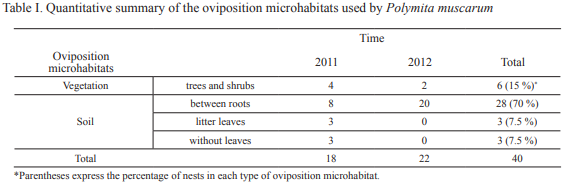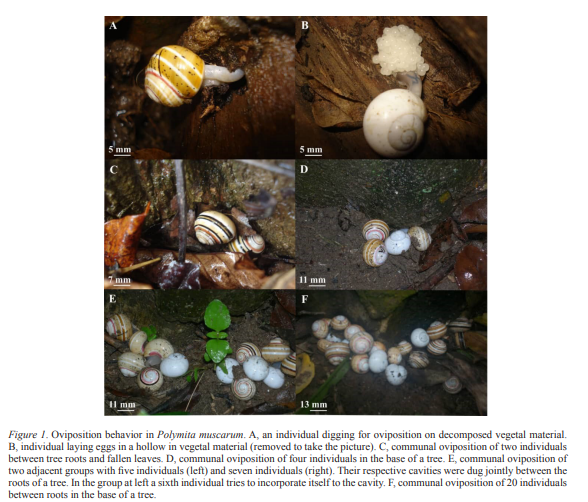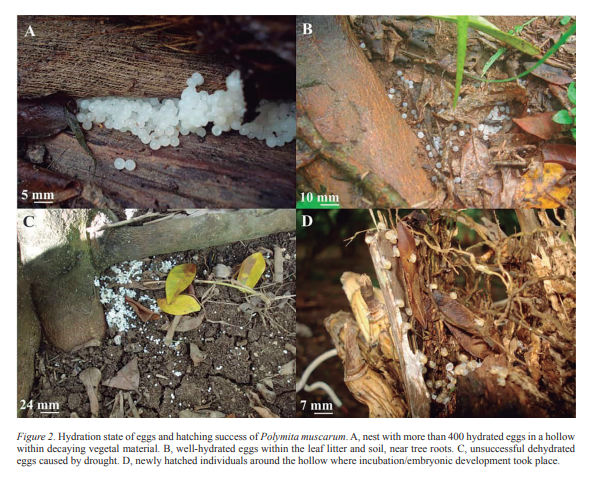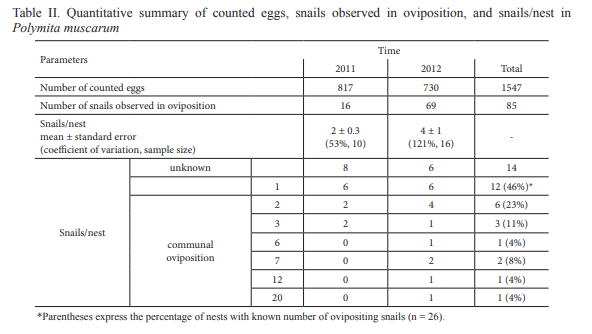Reproductive strategies are structural, functional or behavioral adaptations that influence the likelihood of fertilization and/or the number and survival of offspring in specific microhabitats (Baur & Baur, 2017). Among these strategies, communal oviposition behavior has independently evolved in different animal groups and takes place when two or more aggregated conspecific individuals deposit their eggs in the same place (Doody et al., 2009). The adaptive advantages of this behavior include evasion of predators, social foraging facilitation, and maintenance of optimal microclimate for embryonic development (Waldman, 1982; Dumont et al., 2008; Refsnider & Janzen, 2010; Martens, 2012).
In marine gastropods, communal oviposition is a common and well documented behavior (Giese & Pearse, 1977; D’Asaro, 1991; Pio et al., 2015; Pittman & Fiene, 2020). However, communal oviposition in terrestrial gastropods has not been convincingly demonstrated (Baur & Baur, 2017). In Arianta arbustorum (Linnaeus, 1758) reports exist of aggregated distribution of clutches (Baur, 1988a, 1988b); simultaneous oviposition of more than one individual of Orthalicus reses reses (Say, 1830) and Allogona townsendiana (Lea, 1838) in the same burrow have been noted (Deisler, 1987; Steensma et al., 2009). In addition, Bidart et al. (1989) assumed communal oviposition as potential cause of two nests with clutch sizes of more than 100 eggs from the Cuban endemic tree snail Polymita muscarum (Lea, 1834) in field conditions. Moreover, there are two records of two P. muscarum individuals ovipositing simultaneously in the same hole, in captivity (Reyes-Tur & Fernández, 1998).
The P. muscarum species is a simultaneous hermaphrodite snail with reciprocal spermatophore transfer during mating (Reyes-Tur & Koene, 2007). Regarding reproductive strategies, its life cycle is circannual with seasonal reproduction, essentially between September and November (Díaz-Piferrer, 1962; Bidart, 1997; Bidart et al., 1998; Reyes-Tur & Fernández, 1998). Study of reproductive biology of P. muscarum is a conservation priority due to its status as a threatened species, included in the Cuban Invertebrates Red List (Maceira-Filgueira, 2016). Here, we report data on communal oviposition of P. muscarum in an agroecosystem.
The study took place in a zone characterized by habitat degradation and fragmentation due to prolonged land use for agriculture (Espinosa, 2011; González-Guillén, 2014), specifically in Yaguajay, Banes municipality, Holguín, northeastern Cuba. The data were taken by direct observation and pictures in a fixed plot of 17 m x 7 m (119 m2). This plot lies within an agroecosystem dominated by citrus, but also including guava, banana, and avocado crops. In this agroecosystem individuals of P. muscarum can be found dispersed in habitats not only at the edge but also within the plantation. The plot has been shown by previous research to have improved reproduction of P. muscarum over time, with snails most commonly nesting between roots of citrus trees. For a more detailed description of the studied plot and methodology see Reyes-Tur et al. (2018). Observations were made in 2011 (13 days between October and December) and 2012 (8 days between September and November). Nesting snails were recorded during surveys of 30 min each hour for 4–24 hours/day, depending on the number of nests detected. A flashlight was used in the darkest hours. Data on nest microhabitat characteristics, number of nests/day and number of snails/nest were recorded. When possible, the duration of oviposition (i.e.: nest construction and egg-laying, n = 2), minimum clutch size estimate (n = 17), and incubation time (n = 3) were recorded. In order to avoid any damage to reproductive success due to handling and counting eggs or snails, we estimated the clutch size as the number of eggs visible in pictures taken of nests. In this case, we mainly used pictures of nests from which snails were already departed; therefore certainty regarding the number of snails/nest remained unknown (n = 14). Each photo was analysed by ImageJ which is open-source freeware (Rasband, 1997). Since it was likely there were some eggs hidden on each picture, we interpreted the number of eggs/nest as a minimum clutch size estimate.
Mean, standard error and coefficient of variation were calculated for the minimum clutch size estimate and number of snails/nest. We used the χ2 (Chi-square) test to compare the observed frequencies of nesting snails on different microhabitats, and the expected frequencies if microhabitat use was just random. To this end, microhabitats were distinguished between two types (i.e.: soil, near roots of trees and shrubs vs vegetation, on trees and shrubs). The number of snails/nest was compared between years using a Mann Whitney U test. Statistical analyses were performed using PAST 3.02 (Hammer et al., 2001).
Oviposition took place during rainy days or the day after, and occurred on vegetation or on the soil (Table I), inside hollows or cavities excavated by egg-laying prone snails. During excavation, individuals buried themselves partially or completely in oviposition holes. Though nests on decaying vegetal material and in fallen leaves were found (Figs. 1, 2), nests on wet soil were detected in a proportion statistically different (85 %, n = 40) from what would be expected if microhabitats used for nests were at random (X2 = 19.6; p < 0.001). After egg-laying, holes with eggs inside were typically buried with mucus, wet soil and vegetal material. For each snail, the oviposition duration varied between 2–7 hours (n = 2).



In total, 85 snails and 40 nests were surveyed (Table II); in 26 nests we documented the number of snails/nest (Table II). In 54 % of these 26 nests, 2 or more snails were identified in the same nest (Table II), in a substrate surface area varying between 6–50 cm2 (i.e.: communal oviposition). Although 2–3 snails/nest were the most frequent (34 %; n = 26), up to 20 snails/ nest were observed. Multiple snails often crowded into a single nest within a 30 min span. During communal oviposition we found up to six individuals trying to deposit eggs in the same cavity jointly excavated by them (Fig. 1). Alternately, in other types of communal oviposition, common cavities were used but some nesting snails dug their own cavities alongside (Fig. 1).
In 2012, after Hurricane Sandy precipitation, an increase in the quantity and proportion of communal oviposition occurred in comparison to the previous year (Table II). However, this inter-annual difference in number of snails/nest was not significant (Mann Whitney U = 55; p = 0.17). Detection of communal oviposition, including more than five snails/nest, occurred after Hurricane Sandy in 2012 (Table II), on 25 October (n = 4) and 16 November (n = 1). In total, we counted 1547 eggs (Table II) and the minimum clutch size estimate was 91 ± 22 eggs/nest (n = 17). For two individual nests, the clutch size varied between 100–200 eggs; likewise, clutch sizes between 250–350 eggs were estimated in a communal nest formed by two snails. Furthermore, a nest with more than 400 eggs was registered, but the number of snails/nest remained unknown. The incubation period lasted 10–11 days (n = 3); unsuccessful eggs, likely due to dehydration, remained within the leaf litter and soil (Fig. 2).

In P. muscarum, under field conditions, Bidart et al. (1989) registered two nests with more than 100 eggs, at Las Calabazas, Buenaventura, Holguín, and proposed communal oviposition as a potential cause. Reyes-Tur and Fernández (1998) confirmed two nests with more than 100 eggs as a result of communal oviposition by two snails of this species, in captivity. The present study thus adds confirmation of the suggestion of Bidart et al. (1989) that P. muscarum exhibits communal oviposition in wild habitats, beyond captivity conditions (Reyes-Tur & Fernández, 1998). In some Polymita species, data on individual clutch size averages have been previously identified; for P. muscarum, 42–84 eggs (Bidart et al., 1989, 1998; Reyes-Tur & Fernández, 1998; Reyes-Tur, 2004); P. picta roseolimbata Torre, 1950, 54 eggs (Valdés et al., 1986); P. venusta (Gmelin, 1786), 61–142 eggs (Bidart et al., 1998; Reyes-Tur, 2004) and P. brocheri (Gutiérrez in Pfeiffer, 1864), 89 eggs (Rodríguez-Potrony et al., 2020).
Taking into account the relationship between clutch size and natality coefficient (i.e.: number of hatchings/clutch size) for Polymita species, it has been estimated that a median minimum clutch size of 18 eggs is necessary in order to guarantee natality of at least two eggs/ nest (Reyes-Tur, 2004). Thus communal oviposition seems to be highly useful when the clutch size can reach a minimum value in which reproductive profit is superior to the oviposition investment cost. Communal oviposition could be interpreted as a potentially profitable strategy to increase reproductive success in species such as P. muscarum, with seasonal reproduction being dependent on rainy days and adequate oviposition microhabitats. Several authors have noted that the eggs of terrestrial gastropods are preyed upon by various predators (Barker, 2004; Steensma & Lilley, 2006). Communal oviposition in specific microhabitats could decrease predation risk during embryonic development and in the early days after hatching, as has been analyzed in reviews on this subject (Doody et al., 2009; Refsnider & Janzen, 2010).
In land snails oviposition requires investing in processes of appreciable metabolic cost, starting from oogenesis until the excavation of cavities (Tompa, 1984; Antkowiak & Chase, 2003). Consequently, oviposition is limited by the availability of resources and takes place relatively infrequently. For example, even in the optimal conditions of a breeding farm, only 13 % of the individuals of Cornu aspersum (Müller, 1774) laid eggs more than once in a month, and most (56 %) laid eggs once every three months (Daguzan et al., 1981).
In other land snails, such as A. arbustorum from Switzerland, spatial distribution of oviposition suggests that permanent humidity in microhabitats could exert a strong selective pressure over the selection of oviposition sites. Consequently, clutch aggregations under field conditions reflect the heterogeneity of habitats (Baur, 1988a). In the before-mentioned species, snails laid their own eggs in humid microhabitats, but did not recognize the presence of other eggs previously laid in the same place. For that reason, the presence of two or more clutches in the same place did not suggest an active behavior of communal oviposition. Actually, the eggs of different progenitors laid in the same site constitute a risk because of egg cannibalism (Baur, 1988b). In contrast to A. arbustorum, P. muscarum showed a strong tendency towards aggregation in oviposition substrates. Such aggregation levels have not been documented in any land snail belonging to the Family Cepolidae. Likewise, the possibility of egg cannibalism in the studied species has been discounted (Bidart et al., 1989, 1998; Reyes-Tur & Fernández, 1998). Communal oviposition in P. muscarum follows similar patterns to that described in sea slugs Aplysia spp. (Susswein & Nagle, 2004; Pittman & Fiene, 2020). Curiously, this behavior has not been explicitly registered in terrestrial gastropods (Baur & Baur, 2017), in spite of the evidence for the genetic and physiological potential for its occurrence in this group of gastropods (Stewart et al., 2016). Some differences between aquatic and terrestrial gastropods should be noted. The former generally lay their eggs on the surface of favorable substrates (D’Asaro, 1991; Pio et al., 2015; Pittman & Fiene, 2020); on the other hand, terrestrial mollusks frequently dig or otherwise prepare cavities (i.e. nests) or, at least, invest energy and time in the preparation of an appropriate holding area for their eggs (Deisler, 1987; Steensma et al., 2009; Baur & Baur, 2017). Reutilization and/or collective use of oviposition sites could be interpreted as a way of saving energy consumed in the construction of a new cavity.
In this paper, the function of intentionally communal oviposition behavior could not be demonstrated, but the evidence does suggest association with particular microhabitats for egg-laying. A next step would be to determine whether chemical or other communication is necessary for aggregation during egg-laying in P. muscarum, similar to Aplysia spp., where a released pheromone combination acts as a stimulating signal (Cummins & Degnan, 2010). Another interesting aspect needing further study is the possibility of intraspecific brood parasitism in P. muscarum, behavior only described among land snails in C. aspersum (Fearnley, 1994).
In conclusion, the detection of communal oviposition in P. muscarum during the reproductive season for two consecutive years indicates that this behavior was not random. These results support the potential importance of understanding behavioral ecology and ethodiversity as a tool in conservation programs (Cordero-Rivera, 2017). Management of communal oviposition could be a potential source of eggs and hatchlings for captive breeding and reintroduction in case of extinction of the studied species in particular areas.
ACKNOWLEDGEMENTS
We appreciate logistic and field support offered by the Flores-Ricardo family. Thanks to Alejandro Fernández and Adrián González-Guillén for their support and suggestions. Bruno Baur, John A. Allen, Scott F. Cummings and Joris M. Koene helped with comments on aggregated oviposition in gastropods. We greatly appreciate suggestions, language corrections and writing assistance of Iván Rodríguez López, Adolfo Cordero-Rivera, Kathryn E. Perez, Carlos Suriel and anonymous referees. The work was partially financed by VLIRUOS project: Valorization of Eastern Cuban biodiversity in climate change scenario. Also, we are grateful to Tino Sauer and the NABU agency for their general support.
LITERATURE CITED
Antkowiak, T., & R. Chase. 2003. Sensory innervation of the ovotestis in the snail Helix aspersa. Journal of Experimental Biology, 206: 3913–3921.
Barker, G. M. 2004. Natural enemies of the terrestrial molluscs. CABI Publishing, CAB International. Wallingford, Oxfordshire, United Kindom, 644 pp.
Baur, B. 1988a. Population regulation in the land snail Arianta arbustorum: density effects on adult size, clutch size and incidence of egg cannibalism. Oecologia, 77: 390–394.
Baur, B. 1988b. Do the risks of egg cannibalism and desiccation influence the choice of oviposition sites in the land snail Arianta arbustorum? Journal of Zoology, London, 216: 495–502.
Baur, B., & A. Baur. 2017. Reproductive strategies in stylommatophoran gastropods. In: S. Saleuddin, & S. Mukai (Eds.). Physiology of molluscs: a collection of selected reviews. Volume 2. Pp. 311–377. Apple Academic Press, Waretown, New Jersey, 899 pp.
Bidart, L. 1997. Ecología de Polymita muscarum Lea, 1834 (Gastropoda: Xanthonychidae) en la provincia de Holguín, Cuba. Unpublished. MSc. Thesis. Instituto de Ecología y Sistemática, La Habana. Cuba, 50 pp.
Bidart, L., A. Fernández, & C. Iglesias. 1998. Reproducción en Polymita muscarum y Polymita venusta (Stylommatophora: Helminthoglyptidae). Revista Biología Tropical, 46 (3): 683–689.
Bidart, L., J. F. Milera, M. Osorio, & E. Reynaldo. 1989. Datos reproductivos de Polymita muscarum muscarum Lea (Mollusca: Pulmonata: Fruticicollidae). Reporte de Investigación IES/ACC: 1–8.
Cordero-Rivera, A. 2017. Behavioural diversity (ethodiversity): a neglected level in the study of biodiversity. Frontiers in Ecology and Evolution, 5: 7. https://doi.org/10.3389/ fevo.2017.00007
Cummins, S. F., & B. M. Degnan. 2010. Sensory sea slugs. Communicative and Integrative Biology, 3 (5): 423–426.
D’Asaro, C. N. 1991. Gunnar Thorson’s worldwide collection of prosobranch egg capsules: Muricidae. Ophelia, 35: 1–101.
Daguzan, J., J. C. Bonnet, Y. Perrin, E. Perrin, & H. Rouet. 1981. Contribution à l’élevage de l’escargot Petit-Gris: Helix aspersa Müller (Mollusque: Gastéropode: Pulmoné: Stylommatophore). I. - Reproduction et éclosion des jeunes, en bâtiment et en conditions thermohygrométriques contrôlées. Annales de Zootechnie, 30: 249–272.
Deisler, J. E. 1987. The ecology of the Stock Island tree snail, Orthalicus reses reses (Say). Bulletin of Florida State Museum, Biological Science, 31 (3): 107–145.
Díaz-Piferrer, M. 1962. Reproduction of Polymita muscarum Cuban tree snail. Caribbean Journal of Science, 2 (2): 59–66.
Doody, J. S., S. Freedberg, & J. S. Keogh. 2009. Communal egg-laying in reptiles and amphibians: evolutionary patterns and hypotheses. Quarterly Review of Biology, 84 (3): 229–252.
Dumont, C. P., J. S. Roy, & J. H. Himmelman. 2008. Predation by the sea urchin Strogylocentrotus droebachiensis on capsular egg masses of the whelk Buccinum undatum. Journal of the Marine Biological Association of the United Kingdom, 88: 1025–1031.
Espinosa, J. 2011. Las polymitas. Ediciones Polymita, Ciudad de Guatemala, Guatemala and Ediciones Boloña, La Habana, Cuba, 199 pp.
Fearnley, R. H. 1994. Intraspecific brood parasitism in the landsnail Helix aspersa Müller (Pulmonata: Gastropoda): a new behavioural strategy for the Mollusca. Journal of Molluscan Studies, 60: 193–195.
Giese, A. C., & J. S. Pearse. 1977. Reproduction of marine invertebrates, Volume IV, Molluscs: Gastropods and Cephalopods. Academic Press, New York, 382 pp.
González-Guillén, A. 2014. Polymita the most beautiful land snail of the world. Fundcraft Publishing, Collierville, Tennessee, 359 pp.
Hammer, Ø., D. A. T. Harper, & P. D. Ryan. 2001. PAST: Paleontological Statistics Software Package for Education and Data Analysis. Palaeontologia Electronica, 4 (1): 1–9.
Maceira-Filgueira, D. 2016. Polymita muscarum. In: Hidalgo-Gato, M. M., J. Espinosa, & R. Rodríguez-León. (Eds.). Libro rojo de invertebrados terrestres de Cuba. 115–116 pp. Editorial Academia, Habana, 244 pp.
Martens, A. 2012. Group oviposition in three platycnemidid species (Odonata: Platycnemididae). International Journal of Odonatology, 5 (1): 75–80.
Pio, M. J., G. Pastorino, & G. C. Herbert. 2015. Trophon geversianus (Pallas, 1774): the first record of communal egg masses in the muricid subfamily Trophoninae (Gastropoda). The Nautilus, 129 (4): 172–174.
Pittman, C., & P. Fiene. 2020. Sea slugs of Hawaii. http://www.seaslugsofhawaii.com/index.html (accessed: 03–VII–2020).
Rasband, W. S. 1997. ImageJ. Bethesda, Maryland, U.S. National Institutes of Health. http://imagej.nih.gov/ij/download.html (accessed: 11–X–2019).
Refsnider, J. M., & F. J. Janzen. 2010. Putting eggs in one basket: ecological and evolutionary hypotheses for variation in oviposition-site choice. Annual Review of Ecology, Evolution, and Systematics, 41: 39–57.
Reyes-Tur, B. 2004. Ecología y biología reproductiva de Polymita venusta (Lea, 1834). Unpublished. PhD Thesis. Universidad de La Habana. Cuba, 100 pp.
Reyes-Tur, B., & A. Fernández. 1998. Ciclo de vida y actividad reproductiva de Polymita muscarum, en condiciones de laboratorio. Cocuyo, 7: 14–17.
Reyes-Tur, B., L. A. Flores-Ricardo, & A. Fernández. 2018. Actividad diaria de Polymita muscarum (Gastropoda: Cepolidae) en un agroecosistema: relación con factores climáticos y duración del apareamiento. Revista Cubana de Ciencias Biológicas, 6 (1): 1–9.
Reyes-Tur, B., & J. M. Koene. 2007. Use of the dart apparatus by the hermaphroditic land snail Polymita muscarum (Lea, 1834). Animal Biology, 57: 261–266.
Rodríguez-Potrony, H., C. Bosch-Diaz, M. J. Gordillo-Pérez, J. Rodríguez-Matos, & B. ReyesTur. 2020. Parámetros reproductivos, historia de vida y crecimiento de Polymita brocheri (Gastropoda: Cepolidae) en condiciones de cautiverio. Poeyana, 510: 10–17.
Steensma, K. M. M., & P. L. Lilley. 2006. Assessment of critical habitat and predation effects for the Oregon forestsnail, Allogona townsendiana. Final report, Endangered Species Recovery Fund (World Wildlife Fund), 14 pp.
Steensma, K. M. M., P. L. Lilley, & H. M. Zandberg. 2009. Life history and habitat requirements of the Oregon forestsnail, Allogona townsendiana (Mollusca, Gastropoda, Pulmonata, Polygyridae), in a British Columbia population. Invertebrate Biology, 128 (3): 232–242.
Stewart M. J., T. Wang, B. I. Harding, U. Bose, R. C. Wyeth, K. B. Storey, & S. F. Cummins. 2016. Characterisation of reproduction-associated genes and peptides in the pest land snail, Theba pisana. PLoSONE, 11 (10): e0162355.
Susswein, A. J., & G. T. Nagle. 2004. Peptide and protein pheromones in molluscs. Peptides, 25: 1523–1530.
Tompa, A. S. 1984. Land snails (Stylommatophora). In: A. S. Tompa, N. H. Verdonk, & J. A. M.
van den Biggelaar (Eds.). The Mollusca. Reproduction. Volume 7. Pp. 47–140. Academic Press, London, 486 pp.
Valdés, G., V. Berovides, & J. F. Milera. 1986. Ecología de Polymita picta roseolimbata Torre 1950, en la región de Maisí, Cuba. Ciencias Biológicas, 15: 77–93.
Waldman, B. 1982. Adaptive significance of communal oviposition in wood frogs (Rana sylvatica). Behavioral Ecology and Sociobiology, 10: 169–174.
Cómo citar:Flores-Ricardo, L. A., Gordillo-Pérez, M. J., Bosch-Diaz, C., Steensma, K. M. M. y Reyes-Tur, B. (2021) «Ovoposición comunal del caracol arborícola cubano Polymita muscarum (Gastropoda: Cepolidae) en un agroecosistema », Novitates Caribaea, (17), pp. 187–195. doi: https://www.doi.org/10.33800/nc.vi17.254
